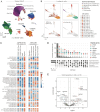This is a preprint.
High-throughput single cell -omics using semi-permeable capsules
- PMID: 40166174
- PMCID: PMC11957016
- DOI: 10.1101/2025.03.14.642805
High-throughput single cell -omics using semi-permeable capsules
Abstract
Biological systems are inherently complex and heterogeneous. Deciphering this complexity increasingly relies on high-throughput analytical methods and tools that efficiently probe the cellular phenotype and genotype. While recent advancements have enabled various single-cell -omics assays, their broader applications are inherently limited by the challenge of efficiently conducting multi-step biochemical assays while retaining various biological analytes. Extending on our previous work (1) here we present a versatile technology based on semi-permeable capsules (SPCs), tailored for a variety of high-throughput nucleic acid assays, including digital PCR, genome sequencing, single-cell RNA-sequencing (scRNA-Seq) and FACS-based isolation of individual transcriptomes based on nucleic acid marker of interest. Being biocompatible, the SPCs support single-cell cultivation and clonal expansion over long periods of time - a fundamental limitation of droplet microfluidics systems. Using SPCs we perform scRNA-Seq on white blood cells from patients with hematopoietic disorders and demonstrate that capsule-based sequencing approach (CapSeq) offers superior transcript capture, even for the most challenging cell types. By applying CapSeq on acute myeloid leukemia (AML) samples, we uncover notable changes in transcriptomes of mature granulocytes and monocytes associated with blast and progenitor cell phenotypes. Accurate representation of the entirety of the cellular heterogeneity of clinical samples, driving new insights into the malfunctioning of the innate immune system, and ability to clonally expand individual cells over long periods of time, positions SPC technology as customizable, highly sensitive and broadly applicable tool for easy-to-use, scalable single-cell -omics applications.
Conflict of interest statement
Conflict of interests Some of the results presented in this work have been filed in patent applications PCT/EP2022/084074; PCT/EP2022/084071; PCT/EP2022/084066; PCT/EP2022/084063. LM is a shareholder of Atrandi Biosciences.
Figures






Similar articles
-
Hydrop enables droplet-based single-cell ATAC-seq and single-cell RNA-seq using dissolvable hydrogel beads.Elife. 2022 Feb 23;11:e73971. doi: 10.7554/eLife.73971. Elife. 2022. PMID: 35195064 Free PMC article.
-
Multi-step processing of single cells using semi-permeable capsules.Lab Chip. 2020 Oct 27;20(21):4052-4062. doi: 10.1039/d0lc00660b. Lab Chip. 2020. PMID: 33006353
-
inDrops-2: a flexible, versatile and cost-efficient droplet microfluidic approach for high-throughput scRNA-seq of fresh and preserved clinical samples.Nucleic Acids Res. 2025 Jan 11;53(2):gkae1312. doi: 10.1093/nar/gkae1312. Nucleic Acids Res. 2025. PMID: 39797728 Free PMC article.
-
Single-cell sequencing to multi-omics: technologies and applications.Biomark Res. 2024 Sep 27;12(1):110. doi: 10.1186/s40364-024-00643-4. Biomark Res. 2024. PMID: 39334490 Free PMC article. Review.
-
Droplet-based single-cell sequencing: Strategies and applications.Biotechnol Adv. 2024 Dec;77:108454. doi: 10.1016/j.biotechadv.2024.108454. Epub 2024 Sep 11. Biotechnol Adv. 2024. PMID: 39271031 Review.
References
Publication types
Grants and funding
LinkOut - more resources
Full Text Sources
Research Materials
